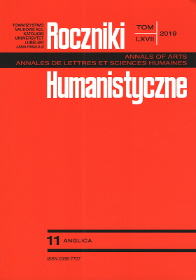Aural/Oral Sonnets of Ted Berrigan
Abstract
The present paper attempts to investigate the problem of interaction of the visual and sound dominants in the composition of a canonical now cycle of The Sonnets created by Ted Berrigan—an American poet of the second generation of New York Poets. The topic is all the more interesting as the sonnet as a poetic form represents a closed form which by definition foregrounds shape and pattern rather than sound. Berrigan’s uniqueness of technique bridges the two extremes of representation by disintegrating the rigid structure of the sonnet and allows the poet to build the poems not out of the blocks of three/four/six/eight line stanzas but out of a single unit of a one line stanza. They undergo, in turn, a dynamic process of random permutations in keeping with theories of aleatory music and collage composition. Furthermore, Berrigan supplements the visual dominant with language substance of colloquial American speech which is “overheard,” appropriated and variously recycled in successive poems. Both theoretical comments of Berrigan and the poems he included in the sequence confirm the centrality of aural/oral dimension of his sonnets.
References
Berrigan, Ted. “Sonnet Workshop: An edited transcript of a talk given at the Poetry Project on February 27, 1979.” Project Papers, vol. II, 1989, pp. 1–10.
Berrigan, Ted. The Sonnets. Penguin Books, 2000.
Fagin, Larry. Shiny. No. 9/10, 1999, pp. 5–31.
Henry, Timothy. “‘Time and Time Again’: The Strategy of Simultaneity in Ted Berrigan’s The Sonnets.” Jacket 2, 2010, pp. 1–38.
Lopez, Tony. “‘Powder on a Little Tablet’: Ted Berrigan’s Sonnets and 1960’s Poems.” Journal of American Studies, vol. 36, no. 2, 2002, pp. 281–92.
Notley, Alice. “Introduction”. The Sonnets, Penguin Books, 2000, pp. v–xv.
Waldman, Ann, ed. Nice to See you: Homage to Ted Berrigan. Coffee House, Consortium Book Sales and Distribution, 1988.
Wącior, Sławomir. “Supersize me: Experiments with the shape and size of contemporary sonnets in English.” Roczniki Humanistyczne, vol. 64, no. 11, 2016, pp. 213–24.
Copyright (c) 2019 Roczniki Humanistyczne

This work is licensed under a Creative Commons Attribution-NonCommercial-NoDerivatives 4.0 International License.





